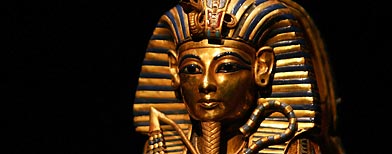
Mystery of King Tut's death solved by DNA
Egypt's famous boy-king suffered from "multiple disorders," an extensive study reveals.
King Tut—plus 10 other royal mummies—recently became the first ancient Egyptians to get their DNA analyzed. The results, published this week in the Journal of the American Medical Association, turned up a treasure trove of new information about the famous boy king, his family and Egyptian royalty in general.
Among the discoveries:
- Tut had a bone disorder that would have forced him to walk with a cane, and which may have been a result of royal inbreeding.
- A mummy known as KV55 has turned out to be Tut's father, Akhenaten, a controversial pharaoh best known for his failed attempt at converting Egypt to monotheism. Based on sculptures and art that depict a feminized Akhenaten, researchers had long suspected that he suffered from a genetic hormone disorder called gynecomastia. But the DNA evidence says otherwise. Instead, Akhenaten's feminine features are likely to have been an artistic conceit, added for symbolic, religious reasons.
- Other previously unidentified mummies are now known to be Tut's grandfather, grandmother and mother.
- Contrary to speculation, Tut's mother probably wasn't his father's chief wife, Nefertiti. She and Akhenaten are never described as being related, and Tut is definitely the product of brother/sister incest.
- King Tut had malaria. He likely died from a combination of that disease and complications of his bone disorder. The malarial DNA found in Tut's body is the oldest genetic evidence of the disease ever found.
National Geographic News: King Tut was disabled, malarial and inbred


No comments:
Post a Comment